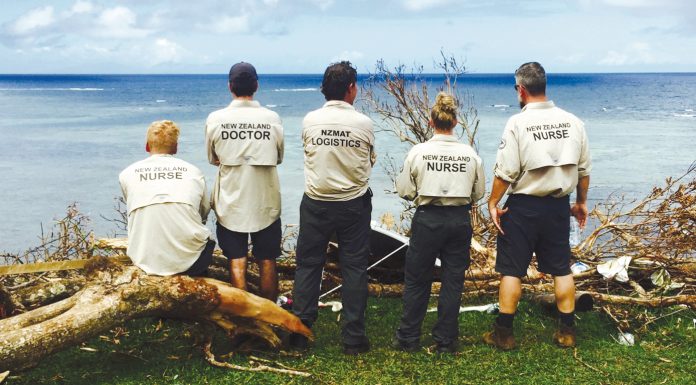Reading this article and undertaking the learning activity is equivalent to 60 minutes of professional development.
This learning activity is relevant to the Nursing Council competencies 1.4, 2.2, 2.3, 2.4, 2.6, 2.7, 2.9, 4.1 and 4.3
Learning outcomes:
Reading and reflecting on this article will enable you to:
- update your knowledge on serious drug allergies as a subset of adverse drug reactions
- identify your responsibilities in the nursing care of a person with a risk of drug allergies
- reflect on medication safety practices in your workplace and identify whether any improvements are required related to preventing drug allergies.
Introduction
As the emergency department nurse starts the first dose of an IV antibiotic infusion, she asks, “You’re not allergic to anything are you?” I reply, “Yes, I’ve a long list of serious drug allergies – all in my notes”. She leaves the infusion running, and with no call bell I sit and wait, wondering if and when I might react to this drug. I have no sense the nurse understands how dangerous a delayed hypersensitivity reaction can be, even after my description of weeks in hospital following one such reaction1.
Adverse drug reactions (ADRs) are common, and for patients who experience an ADR, that experience can be distressing, painful, and one that they revisit every time they are prescribed another medication.
About 80 per cent of ADRs are classified as Type A reactions, which are predictable and dependent on the drug dose (Table 1). About 15–20 per cent of ADRs are Type B reactions, which are unpredictable and independent of the dose2,3.
It is this last group of drug reactions, specifically the immunologically mediated reactions, that are the focus of this article. Although categorised as ‘unpredictable’, there is much nurses can do to prevent patient harm from these reactions.
It’s not all about anaphylaxis
While many patients report drug allergies, the true incidence is unknown3. It is complicated by a number of factors, including:
- skin symptoms such as rashes can be related to other conditions, for example infections, rather than to an allergy4
- patients often report or self-diagnose ‘allergies’ to drugs, when that diagnosis may not have been confirmed
- patients report another category of reaction, such as a recognised side effect, as an allergy. Think about how often patients report nausea as an allergy symptom.
Therefore, identifying allergies and ADRs requires careful assessment and identifying an allergic reaction as the source of symptoms may not be straightforward.
Nurses learn about anaphylaxis, but that is only one of a number of types of potentially fatal allergic reactions to medications. Other serious reactions that result from different immune responses are now categorised as types of severe cutaneous adverse reactions (SCARs)3 (see tables 2 and 3).
Drugs are one of the major causes of these relatively rare and idiosyncratic syndromes. For example, between 1965 and 2004 the New Zealand Centre for Adverse Reactions Monitoring (CARM) received 585 reports of SCARs associated with medicines or vaccines5. At that time CARM identified the antibiotic Cotrimoxazole as responsible for 77 SCAR reports5, while more recently NSAIDs have been associated with 41 case reports6. SCARs can cause significant morbidity, including blindness and disfigurement and, depending on the syndrome, have a mortality rate of 5–40 per cent7. Any treatment can be difficult and protracted.
It was one of these SCAR reactions that resulted in the widely reported death of New Zealander Eunice Richardson in 2013. Mrs Richardson was prescribed and given Trimethoprim, even though she had had a previous severe reaction to this medication8. In this tragic case both her MedicAlert® bracelet and written warnings of her allergy status on all pages of her clinical record were insufficient protection for her, with fatal consequences8. (See link to video and exercise in the Recommended Resources’ section.)
TABLE 1:
| Type A reactions –
predictable & dose dependent (~80% of ADRs) |
Type B reactions –
unpredictable & dose independent (~15-20% of ADRs) |
| • Overdose
• Side effects, e.g. gastrointestinal bleeding with non-steroidal anti-inflammatories [NSAIDs], • Secondary effects • Drug-drug interactions e.g. Erythromycin + Warfarin = potential increase in blood drug levels |
· Drug intolerance, e.g. tinnitus with aspirin
· Drug idiosyncrasy · Pseudo allergic reactions · Immune-mediated drug hypersensitivity reactions
|
The ‘anatomy’ of an adverse event
In every adverse event, such as Mrs Richardson’s case and in the personal experience recounted at the start of this article where the nurse didn’t check the allergy status before preparing a drug for administration, there is a multitude of potentially contributing factors. Some factors are organisational; for example, clinical record policies. Others are situational, such as interruptions during the drug administration processes and heavy nursing workloads.
Investigations of adverse events often find that a nurse’s mistaken belief that they ‘know the patient9, is a contributing factor. In those circumstances the usual checking of allergy details – when a drug is prescribed and about to be administered – can be missed and cues, such as a MedicAlert® bracelet, overlooked.
The New Zealand Health Quality and Safety Commission currently has a National Medication Safety Programme underway aiming to reduce preventable harm from medication errors and adverse drug events, including drug allergies. This multifaceted safety programme includes the development of the national medication chart and raising awareness of medication risks. Additional work, following the case of Mrs Richardson, has been the distribution of a ‘safety signal’ to New Zealand health professionals about risks of serious adverse drug reactions, including ways to reduce risks10,11.
The key to reducing risk is to identify that prevention is possible.
Preventing or minimising SCARS (and other drug allergies)
Although some allergic reactions to drugs cannot be prevented or foreseen, there is much that nurses can do to minimise the impacts of these severe adverse reactions:
Don’t overlook blank or incomplete allergy and adverse drug reaction information
Adverse drug reaction information can be obtained from multiple sources, including patients, the family or whānau, carers, clinical records, the national medical warning system and MedicAlert®. A blank space in the allergy and adverse drug reaction section on a clinical record should be a red flag to nurses that the chart is incomplete and needs updating.
“Taking a medication history is an integral part of any patient’s diagnosis or treatment. Within that history, it is important to find out if the patient has had any previous allergies or adverse drug reactions and what the reactions were, as these can influence clinical decisions. The patient’s clinical records, whether paper or electronic, should be checked for this information” 11.
Just as important as this process of checking is making sure that any new reactions are diagnosed, and documented thoroughly, including on transfer and discharge summaries11. Patients need to be given accurate information about that reaction and the steps they should take to prevent future reactions. This is the time to talk to patients about applying for a MedicAlert® bracelet, or updating their MedicAlert® records.
Table 2: Categorisations of reactions
| Severe cutaneous adverse reactions (SCAR) syndromes3 | |
| SJS/TEN | Steven Johnson syndrome/ Toxic epidermal necrolysis |
| DiHS/ DRESS | Drug-induced hypersensitivity syndrome/Drug rash with eosinophilia and systemic symptoms |
| AGEP | Acute generalised exanthematous pustulosis |
Table 3: Immune-mediated reactions
| Types of immune-mediated adverse drug reactions2, 7, | ||||
| Hypersensitivity reaction | Mechanism | Examples | Symptoms may include | Symptoms may start after drug commenced- immediate or delayed |
| Type I
|
Immunoglobulin E-mediated | Anaphylaxis, angioedema & urticaria | E.g. hypotension, urticaria, laryngeal oedema, bronchospasm | Immediate (minutes to hours) |
| Type II | Immunoglobulin M or G-mediated (tissue-specific) | Haemolytic anaemia & organ-specific reactions | Depends on the tissue, e.g. anaemia or thrombocytopenia | Immediate or delayed |
| Type III | Immune complex-mediated | Serum sickness & drug fever (delayed) | Fever, lymphadenopathy, urticaria, arthralgia, other rashes | 1-3 weeks |
| Type IV
SCAR syndromes |
Cell-mediated
(T-cells) |
SJS/TEN | Epidermal detachment, purpuric macules, mucosal lesions and kidney, liver, eye & lung involvement,
fever and malaise |
1-8 weeks |
| DRESS/DiHS | Facial oedema, fever, eosinophilia, plus lymphadenopathy, hepatitis, lung, kidney, thyroid and myocardial inflammation in some cases | 3-12 weeks | ||
Ask patients and their whānau to ‘speak up’ about their allergies
A research project – during which all patients were given a questionnaire about drug allergies and were asked to ‘speak up’ about previous reactions – resulted in a significant increase in documented allergy information. This process also provided nurses with greater opportunities to clarify with patients whether their reactions were minor side effects or allergic reactions, and to then establish if this information has been entered on the patient management system12.
Ask a pharmacist to do a medication review
With their specialist knowledge of drugs and cross sensitivities pharmacists are well placed to review prescriptions, reported drug allergies, and also to review drug allergies recorded under a patient’s National Health Index number.
“I had a reaction to a cough syrup with Actidil in it. Years later I had a bad reaction to Benadryl. I didn’t know I could be allergic to an antihistamine so I talked to a pharmacist, who told me the drugs were related. No doctor or nurse had ever told me that1.”
Know the patients most at risk of a drug allergy
Genes play a part for some patients who have serious drug allergies, however genetic testing is not commonly used in clinical practice. However, nurses can be alert to:
- Specific drugs more likely to cause allergic reactions, such as chemotherapeutic agents3
- ‘Allergic’ patients, those who have had a previous drug allergy, and especially those with multiple allergy syndrome, who have reacted to more than one type of drug in the past2
- Specific concurrent medical conditions, including patients with Epstein-Barr virus, HIV, asthma, malignancy, autoimmune disorders, and immune compromised patients3.
Recognise and act on early signs
Not all reactions are immediate. SCAR syndromes can take between one to eight weeks before symptoms occur, even developing after the drug has been discontinued (table 2). Symptoms often last for weeks, even with supportive treatments, or may even become permanent. Therefore, consider allergies if a patient reports new symptoms after a drug has been administered or discontinued. Importantly, the prognosis in SCAR cases can be improved by stopping the suspected medication as soon as possible5. Therefore, know your local policy for withholding a medication dose and reporting a suspected allergy.
Report inadvertent prescribing or administration of drugs to ‘allergic’ patients
Even if no reaction occurs, report any instances where drugs are prescribed to a patient known to be allergic to those medications. These incidents should be analysed to prevent future cases.
Acknowledge the limitations of the ‘five rights’
The five rights of safe drug administration (right patient, time, drug, dose, and route)
do not overtly include provision for checking patient histories for drug allergies13. Nurses can help prevent adverse reactions by having a comprehensive knowledge of the drugs they may prescribe and administer, and good patient knowledge to identify those most at risk. Other responsibilities include reporting drug reactions to CARM, which can update details in the patient’s records via their National Health Index number through the Medical Warning System. It is also important that nurses know and follow their district health board and organisational adverse drug reaction policies, which will provide details on local policies. This will include, for example, the use of coloured stickers on clinical records, additional allergy bracelets, and entries in the patient management system.
Conclusion
Any of us can have an adverse drug reaction; however, some reactions can be prevented by good prescribing and drug administration practices, including knowing which patients are most at risk and which drugs are the most likely culprits. Nurses need to understand the types of drug reactions so that they can help patients differentiate between known side effects and allergies, can spot early symptoms, and can provide appropriate care for patients who have reactions. That care includes ensuring steps are taken to reduce future allergic reactions to medications.
Ask your patients about their drug allergy history, listen to what they say, document carefully, and remember SCARs are much more than skin deep and can kill, but also remember that many of those serious reactions can be prevented.
View PDF of this learning activity here >>
Recommended Resources
The Health Quality And Safety Commission New Zealand provides details in its user guide on correct use of the National Medical Chart and specifically the documentation of allergies and adverse reactions: National medicationchart user guide (2nd edition). www.hqsc.govt.nz/assets/Medication-Safety/NMC-PR/NMC-UserGuide-Aug-2015.PDF
Greater detail on the physiology underpinning drug allergies can be found on YouTube, with Ashley Khan’s presentation ‘But I’m allergic to that… a closer look at drug allergies’: www.youtube.com/watch?v=rh15FhXwzQE
The United Kingdom National Institute For Health And Care Excellence provides an excellent guideline: Drug allergy: diagnosis and management. NICE guideline [CG182]. www.nice.org.uk/Guidance/CG183
The Press: Watch the two-minute interview with the husband of drug allergy victim Eunice Richardson, in which he recounts his experience. Note down all of the times when this fatal reaction could have been prevented. www.stuff.co.nz/the-press/news/69258944/allergic-reaction-to-antibiotic-medication-kills-woman
About the authors:
- Lesley Batten RN PhD is a senior researcher at Massey University, Palmerston North.
Marian Bland RN PhD is the quality coordinator at Ranfurly Residential Care Centre, Feilding, and a health care auditor.
This article was peer reviewed by:
- Kathleen Brown RN MN is an NP in lifespan acute care working in Palmerston North’s Central City Medical Centre.
Anecita Gigi Lim RN PhD is a senior lecturer at The University of Auckland’s school of nursing, teaching nurse prescribing and pharmacology.
References
- Personal anecdotes of LB
- BLUMENTHAL K, SAFF R, & BANERJI A (2014) Evaluation and management of a patient with multiple drug allergies. Allergy and Asthma Proceedings 35 197-203.
- THONG B, & TAN T (2011) Epidemiology and risk factors for drug allergy. British Journal of Clinical Pharmacology 71(5) 684-700.
- HEINZERLING L, TOMSITZ D, & ANLIKER M (2012) Is drug allergy less prevalent than previously assumed? A 5-year analysis. Epidemiology and Health Services Research 166, 107-14.
- MEDSAFE: NEW ZEALAND MEDICINES AND MEDICAL DEVICES SAFETY AUTHORITY. (2005). Severe cutaneous adverse reactions: More than skin deep. Prescriber Update 26(2) 28-29.
- MEDSAFE: NEW ZEALAND MEDICINES AND MEDICAL DEVICES SAFETY AUTHORITY. (2012) NSAIDs can SCAR (Severe Cutaneous Adverse Reaction). Prescriber Update 33(2) 11-12.
- MAROTTI M (2012) Severe cutaneous adverse reactions (SCAR) syndromes. Revista da Associacao Medica Brasileira 58(3) 276-278
- THOMAS, R (2015, June 12) Hospital warned about Eunice Richardson’s allergy before fatal mishap. The Press www.stuff.co.nz/the-press/news/69341672/hospital-war
- DOUGHERTY L, SQUE M, & CROUCH R (2012) Decision-making processes used by nurses during intravenous drug preparation and administration. Journal of Advanced Nursing 68(6) 1302-1311.
- HEALTH QUALITY & SAFETY COMMISSION NEW ZEALAND. (2015, September) Safety signal: The risk of serious adverse drug reactions. Retrieved January 2016 from www.hqsc.govt.nz
- HEALTH QUALITY & SAFETY COMMISSION NEW ZEALAND (2015, 14 September) Medical ID bracelet incident timely med safety reminder. Retrieved January 2016 from www.hqsc.govt.nz/our-programmes/medication-safety/news-and-events/news/2303
- VALENTE S, MURRAY L, & FISHER D (2007) Nurses improve safety with medication allergy and adverse drug reports. Journal of Nursing Care Quality 22(4) 322-327.
- GEORGE E, HENNEMAN E, TASOTA F (2010) Nursing implications for prevention of adverse drug events in the intensive care unit. Critical Care Medicine 38(6) S136-144.
- NURSING COUNCIL OF NEW ZEALAND (2012). Competencies for registered nurses. Retrieved January 2016 from: www.nursingcouncil.org.nz/Publications/Standards-and-guidelines-for-nurses






















